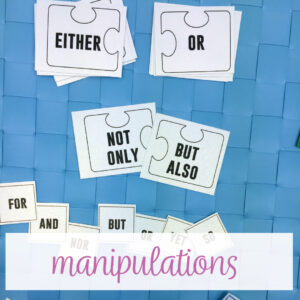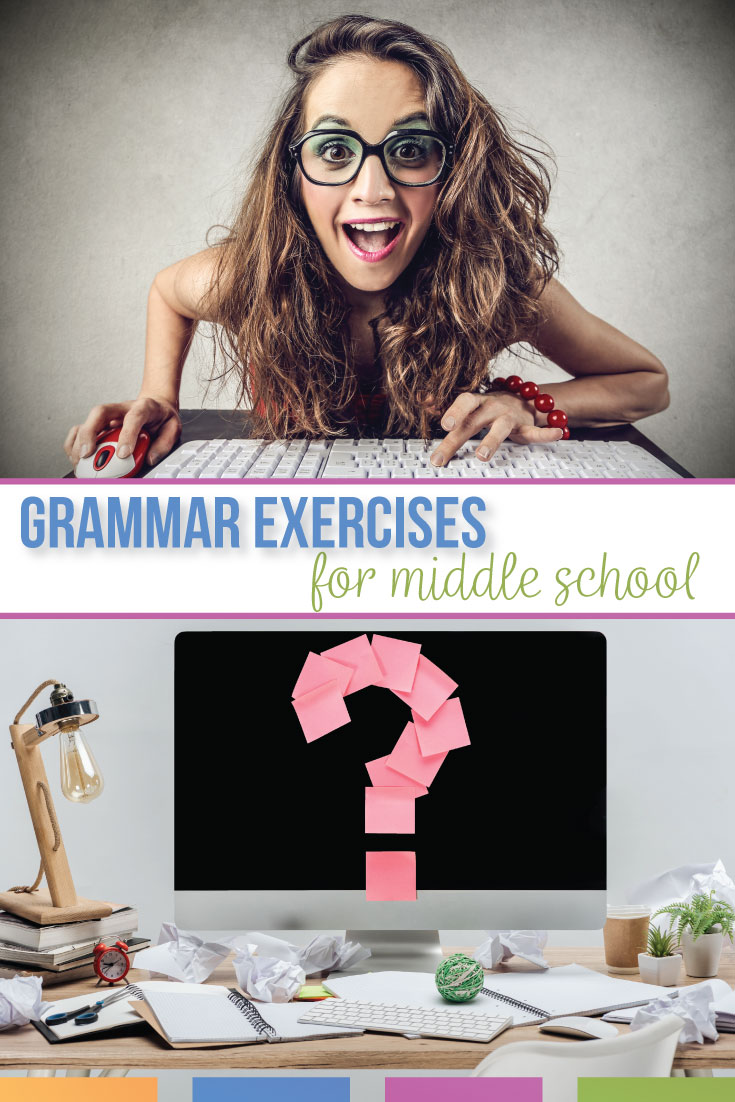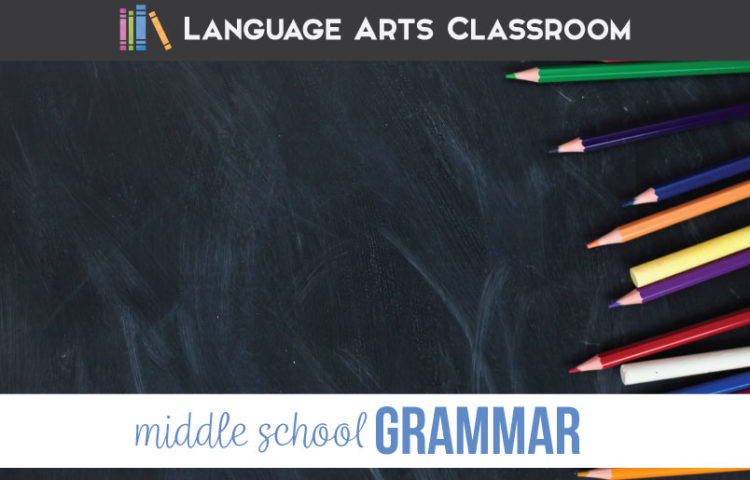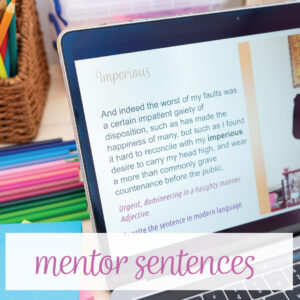I’ve taught middle school grammar before. Here are a few tricks I developed to make grammar for middle school meaningful, for making grammar exercises for middle school count.
I taught middle school… six years ago? My administration provided a straightforward directive: meet the Common Core Standards.
Ok. I’ve worked with standards before. I knew I could teach the material and meet the standards, but of course I wanted to move beyond that. Additionally, I don’t want students to hate lessons, and students should understand the application to their lives. I also developed a diverse grammar program for middle school. Overall, I felt a big responsibility to developing worthwhile grammar activities for my middle schoolers.
I ended up loving teaching grammar! Grammar lessons for middle school should contain multiple opportunities to show understanding, to experience growth, and to connect grammar to writing.
When I was asked to write my first book, I knew that I would learn even more working alongside a team of editors and linguists. I’m a teacher, and I want to share every little bit that I experienced as I wrote my book. Hopefully, these ideas will enhance your grammar exercises for middle school.
To help you make grammar lessons fit your community of learners, I created a free lesson planning download to prompt you with creating dynamic grammar lessons. Find it here:
Now, here are other ideas to make middle school grammar lessons work.
Make the lessons yours.
Teaching grammar in middle school requires personality. Just as you have favorite literature and writing lessons, discussions, and activities, you will soon have beloved grammar activities.
Grammar exercises for middle school should be engaging and contain similar elements that other concepts contain. My first piece of advice for personalizing grammar programs for middle school is to make the lesson yours. Think about your favorite tools for other parts of class—one pagers, graphic organizers, . Teaching grammar in middle school requires a variety of tools for a variety of learners.
Graphic organizers
For instance, I love graphic organizers, so I created one that connects grammar to writing. (You can download it for free.) Students can organize their information while they experience grammar without a basic worksheet. Teaching grammar in middle school works well with graphic organizers. Students can add examples and notes. I can communicate with students on the organizer.
If you use the digital version of that graphic organizer, students can add images that support their understanding. Then, grammar lessons can easily turn into written explanations.
Interactive notebooks
Second, as you work with grammar, you’ll find more pieces that work with your community of learners. For instance, I spoke at a conference a few weeks ago, and a teacher told me that she has students uses green (for “go”) with verbs. She has other color-coding methods, and she’s found great success with this. Perfect!
When I use interactive notebooks, students and I built a similar system that made sense for our class. Interactive notebooks are a terrific way for teaching grammar in middle school. Color-coding and creating meaning together builds a classroom community.
The more experience you have teaching grammar in middle school, the more metaphors and ideas you’ll develop to explain concepts. For instance, I am a big “food” person. When I cover the parts of speech, I use the image of a bowl of fruit, and a sentence is a fruit salad. We discuss the ideas and work with them to make sense of the concepts.
Mentor sentences
Third, many teachers use mentor sentences for middle school grammar lessons. Whatever we are reading (literature or informational texts), I ask students to choose specific examples that deal with a grammatical concept. Students are reviewing the content, and they are developing plentiful examples of mentor sentences. The second approach is to simply ask students to find sentences that interest them. Then, as a class, we can explore one mentor sentence example at a time.
Mentor sentences may be my favorite way of teaching English grammar for middle school. When I teach high school, the sentences that I choose are often what my students choose. That’s not the situation with middle school students, and I feel their choices provide insight into their lives.

Manipulatives
Fourth, many grammar programs for middle school include grammar manipulatives. Students might be able to write in complete sentences. Can they break down a sentence and explain each section’s purpose? Using grammatical pieces is an effective tool in analyzing language, connecting grammar to writing, and teaching punctuation. Grammar for middle school can be hands-on!
The overall message, no matter how you develop grammar exercises for middle school: You can make grammar lessons yours. Look for what your students learn from. Find what resonates with a class. Discovering what “clicks” might take experimentation. More than likely, a combination of direct instruction, hands-on activities, and grammar sorts will be the ticket.
Explain the why.
Grammar exists on standardized tests. College professors aren’t especially cruel, but the expectation for college is that students will be able to write and communicate effectively. A knowledge of language helps students achieve these goals. Finally, future lawyers and business people need a depth knowledge of ways to communicate. When teachers approach literacy and writing in a variety of ways, they are setting students up for success.
Basically, don’t shy away from explaining to students why they are studying language. We have plenty of reasons! Teaching grammar in middle school can appreciate the importance of understanding language.
My high school students have college entrance tests looming, and they typically understand the questions are grammatical… and that those tests reflect what their future college professors will expect them to know. Additionally, more advanced standards reflect what adults should know: The English language changes. As students read more and handle more difficult material, they will experience different manipulations of their language. They should be ready to analyze. My favorite way to demonstrate the power of language is to ask students for a memorable advertisement. The language in their examples will be very articulate.
Finally, college does not dominate middle schoolers’ thoughts, but opportunities exist for connecting grammar to students’ lives. Typically: pronouns… pronouns everywhere. Students often use “it” and “this” with no antecedents. Correct pronoun use will improve and clarify their writing. Find examples such as pronoun use to show students that grammar knowledge improves other lessons.
We teachers naturally explain the why with other components of class; remember to include explanations for grammar too. Doing so increases student buy-in.

Provide direct instruction.
Of course a grammar worksheet or workbook should not be the only grammar instruction. Direct instruction, however, provides the basics and can be useful. Don’t dismiss this tool. Students should know definitions, examples, and lists. Always use the workbook and then apply those concepts to student writing and the literature from class. Whatever grammar programs for middle school you use, direct instruction will be a piece.
For instance, when I teach subordinating conjunctions, I often remark to students that they know because. Students use that word all the time. As another tool for writing, they should also know although, after, and before. The direct instruction needn’t be painful! Remind students you are supporting them.
Next, what teachers do after the direct instruction, matters. Don’t simply end grammar instruction with definitions and lists. My grammar book for middle school has direct instruction, practice, and application.
For instance on pages 194-195 of The English Grammar Workbook for Grades 6, 7, and 8, I have a lesson on connotation and denotation. Students should understand the meanings of these words, but after they do, have fun! Start with the sample sentences and invent other sentences. Tell students to play with words in the dictionary. Ask them to:
- Make a sentence that no one in our culture would use because of the connotation.
- Create an ornery sentence and a helpful sentence.
- Use vocabulary from a recent lesson to build a list of positive and negative connotations for each word.
Those activities are merely one example of how to build off direct instruction! Provide multiple ways for students to experiment with their language after direct instruction. Once you start connecting grammar to other parts of class, students will retain the information. Grammar exercises for middle school can and should run through all parts of Bloom’s.
If you are knew to teaching grammar or are uncomfortable teaching grammar—I understand. When you experiment and work with students, the methods and examples will start. Plus, some students love grammar! You will find success.
My closing thought: Remind students that thinking about and understanding the depths of their language is powerful. Illustrate how grammar relates to vocabulary, writing, and literature. Don’t be afraid to experiment and make the lessons your own. Other lessons will be easier because of their foundation with grammar. When working with middle school grammar lessons, moving beyond basics will engage students.
Those are my tips for making grammar lessons for middle school successful. Personalize the lessons, explain the why to students, and don’t fear direct instruction. Then, move to engaging activities with your middle school students. Teaching grammar in middle school can easily become the best part of your workday.
Do you use my grammar book for middle school, The English Grammar Workbook? I have supplemental material that will work alongside your grammar workbook. Finally, if you’d like free activities, subscribe below:
This post contains affiliate links. Please read my disclosure statement.
Are you still looking for grammar for middle school and tips for teaching grammar in middle school? Join my Facebook group, Grammar Gurus. You’ll meet kind educators who love to chat all ideas English grammar for middle school.






